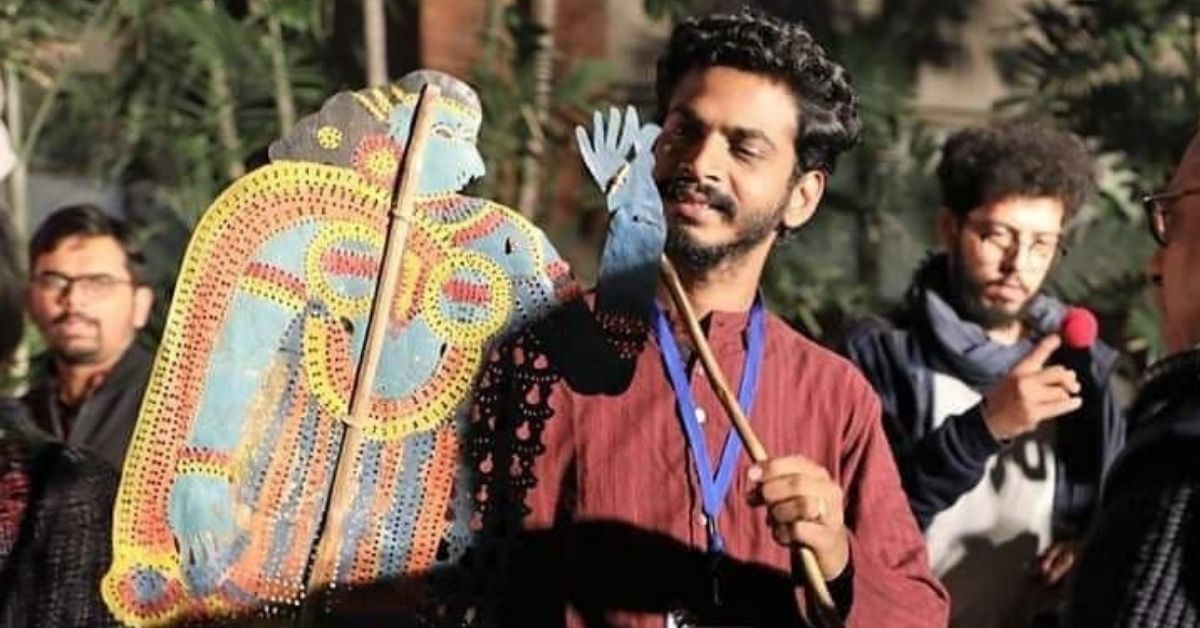Engineer Quits Job, Uses Robotics to Save Father’s Legacy of Leather Puppetry
Strap: Sajeesh Pulavar from Kerala incorporated robotics in the traditional art form of Tholpavakoothu puppetry, which is now displayed in the District Heritage Museum of Palakkad.

When the administrators of Palakkad District Heritage Museum, also known as Mani Iyer Museum, approached Sajeesh Pulavar to make some dolls, he remembers thinking back to a puppetry automation idea shared by his relative.
“In 2015, I discussed this project with my cousin who works for Inker Robotics. Considering the huge expense, we dropped the plan. But when the pandemic struck, the idea was reignited,” says Sajeesh.
The Kerala native incorporated a first-of-its-kind robotics technique in the 700-year-old traditional art form of Tholpaavakoothu that is now displayed in a museum.
Tholpaavakoothu involves the movement of dolls made of leather to narrate the epic Kambaramayana. Traditionally, the act is done manually behind a screen by lighting oil lamps. Usually performed in temples, the shadow of dolls moving gracefully is a visual delight.
He adds, “With the funding from museum authorities and a Delhi-based interior designing company, the episode of Lord Rama’s pursuit to catch the golden deer was selected for the robotic application. A total of four leather puppets, which included Lord Rama, Goddess Sita, Lakshmana and the deer, were automated. It cost Rs 1,50,000 to complete the project.”
The puppets are made and then comes the coding. It took months of brainstorming and effort to finally complete the process in 2020.
However, Sajeesh doesn’t consider robotics as an alternative to manual performance. He sees it as a method to bring in the interest of people to this ‘dying art’. “It is impossible to automate the whole art form. A team of 8-10 artists perform at temples for 21 days from 10 pm to 5 am which makes an aggregate of 210 hours. No machine can replace human perfection in this art,” says the 32-year-old BTech graduate.
Hailing from the traditional Pulavar family who are masters in Tholpavakoothu, Sajeesh left his job in an MNC to help his father Lakshmana Pulavar in preserving the art.

The 13th generation of the Pulavar family, Sajeesh’s childhood memories mostly involve a temple, the golden light from oil lamps and shadows of puppets. “I almost knew 30 songs down pat. I was and still am crazy about this art form which never fails to amaze me,” he says.
So, rather than sticking to the old norms of performing at temples, he started to experiment with different formats at various stages.
“We can’t deviate from the traditional methods at temples as people do it as an offering. But on other stages, we have much more freedom to gain the traction of more people other than the temple-going masses,” he adds.
To date, he says, he has completed hundreds of Tholpaavakoothu puppet shows.

Asked about the income from such shows Sajeesh says, “Major part of our income comes from temples itself. During the offseason, we engage in preparing the puppets as well as performing at stage shows. I continue to work in a company so that we don’t have to completely rely on the art form.”
Apart from performing on stages, Sajeesh conducts workshops/classes for school/college students and arranges shows as part of the government’s awareness programmes. He also travels to learn more about puppetry and its diversification.
“Our puppets are displayed in various parts of the country, including Bengaluru and Delhi. The robotic display is arranged for the first time in India. Countries like China already have such exhibitions,” says Sajeesh in pride.
This passionate youngster is a recipient of the Yuva Pratibha award (folklore) of the State Government in 2020 and has staged hundreds of programmes in multiple parts of the world.
(Edited by Yoshita Rao)
If you found our stories insightful, informative, or even just enjoyable, we invite you to consider making a voluntary payment to support the work we do at The Better India. Your contribution helps us continue producing quality content that educates, inspires, and drives positive change.
Choose one of the payment options below for your contribution-
By paying for the stories you value, you directly contribute to sustaining our efforts focused on making a difference in the world. Together, let’s ensure that impactful stories continue to be told and shared, enriching lives and communities alike.
Thank you for your support. Here are some frequently asked questions you might find helpful to know why you are contributing?


This story made me
-
97
-
121
-
89
-
167













